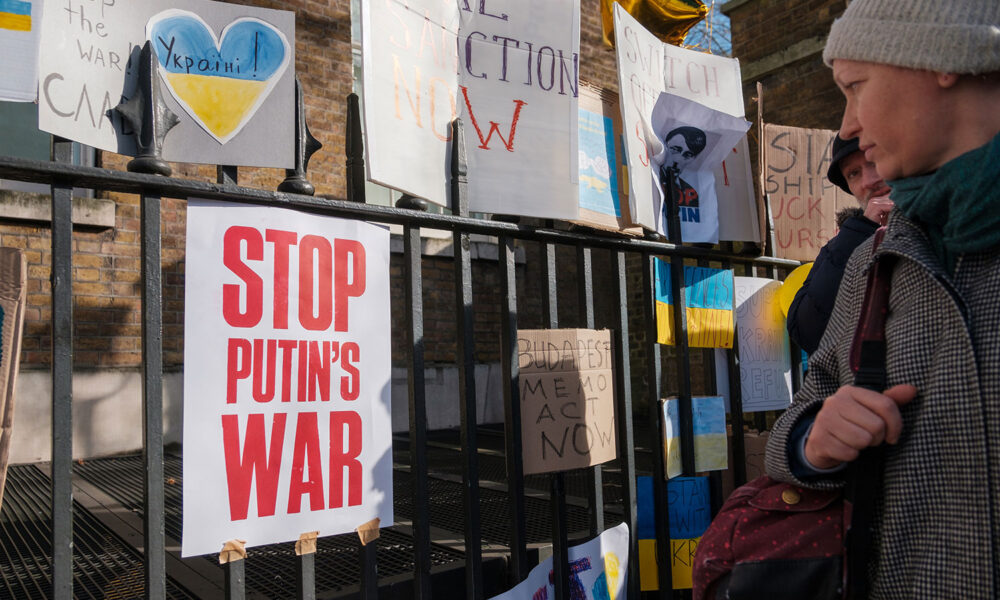The world is a changed and very dangerous place. Russian President Putin has turned a central premise of nuclear deterrence – that it is a stabilizing force – on its head.
On February 27, Putin raised the stakes in Ukraine by declaring he was increasing the alert level of Russian nuclear forces, while Belarus announced it was renouncing its non-nuclear status and would be open to hosting Russian nuclear weapons on its soil. This follows Putin’s earlier threat that any attempt by other countries to interfere in Ukraine would lead to “consequences you have never seen” – which many interpreted as a threat to use nuclear weapons.
In short, a nuclear-armed superpower is using naked military aggression against a neighboring state and rather than serving as a constraint against war, nuclear weapons are being used to deter other countries from getting involved in a conventional war.
President Putin has taken military risks repeatedly in the past, from Georgia to Crimea to Syria, and has not faced serious international consequences. This time, the West responded dramatically, with harsh sanctions, removal of Russia from many elements of the international economic system, and rapid expansion of military and economic assistance to Ukraine.
As a result, Russia’s stock market has nose-dived, the value of the ruble has collapsed, and it is no longer clear that Russia’s vastly larger military forces will be able to quickly takeover much of Ukraine, as previously predicted.
In this situation, the West should consider what a frustrated, nuclear-armed Putin might do. And he could do enormous harm, very quickly. Russia has a large, capable nuclear arsenal, including as many as 2,000 short-range missiles that could lay waste to Ukraine, the Baltic states, and Finland. If these short-range missiles were deployed to Kaliningrad – a Russian territory north of Poland – or Belarus then Putin could also threaten Poland, Slovakia, and Sweden. Russia’s long-range, land-based and sea-based nuclear missiles threaten most of the rest of globe, including all of Europe and the United States.
Response from the West
To date, the United States and the West have, wisely, been restrained in their response. US Strategic Command declared there had been no change in US nuclear posture, and White House press secretary Jen Psaki repeated the declaration recently made by the five original nuclear weapon states – the US, Russia, China, the United Kingdom and France – that a nuclear war cannot be won and must never be fought.
That is good. But Putin is still Putin, but now broke, isolated, and losing – or at least not yet winning – a war that he expected to be quick and painless. The nightmare scenario is that, to protest continued Western supplies of arms, Putin launches a limited nuclear strike against Ukraine, and warns more will be forthcoming unless arms imports stop. The West would face a difficult choice.
Who orders a nuclear strike?
One small, potentially positive piece of information is worth noting. It is believed that Russia, unlike the United States, requires multiple officials to authorize a nuclear strike. As explained in this UCS issue brief, Russia has three satchels that control Moscow’s nuclear weapons, one with the president, one with the secretary of defense, and one with chief of the general staff (roughly equivalent to the chairman of the joint chiefs of staff in the United States). It is possible—though not certain—that all three must agree before a nuclear strike can be launched. If true, that would mean Putin could not by himself order a nuclear attack.
It is a notably better system than the one developed by the United States, which, in an effort to maximize speed, gives the president the sole authority to launch a nuclear strike. The US could reduce the risk of one person’s poor judgement causing a nuclear disaster by requiring two other officials in the line of presidential succession agree with a nuclear strike order before it can be carried out. It was among the proposals noted in a letter from 31 members of Congress members suggesting a change to the system.
First use of nuclear weapons
Putin’s nuclear threats highlight one area where US and Russian nuclear policy are similar: both countries retain the right to use nuclear weapons first in a conflict. Official Russian policy declares that nuclear weapons would only be used when “the very existence of the state is in jeopardy” — and Putin has claimed Ukraine’s close ties to the West threaten Russia’s existence. However, there has also been speculation among some, particularly US-based nuclear hawks, that Russia would use short-range nuclear weapons first in a conflict to raise the stakes and pressure other countries to stop fighting and surrender, or not get involved in the first place. While this speculation is strongly disputed, this seems to be what Putin was threatening in the Ukraine conflict.
For its part, the Trump administration, in 2018, announced a broader role for nuclear weapons, declaring that nuclear weapons would only be used “in extreme circumstances to defend the vital interests of the United States, its allies and partners.” Those circumstances could include a fairly broad set of non-nuclear attacks, including attacks on “civilian population or infrastructure.”
Both countries would be better off if they explicitly declared that they would never use nuclear weapons first. It would limit the possibility that a conventional attack or missile test (like the one the US just postponed) is misinterpreted as a nuclear attack, setting off a horrific chain of events. Breaking the seventy-six year-long taboo against nuclear use would permanently alter the shape of global security going forward. It would open a Pandora’s box of challenges, upending the international regime created to halt the spread of nuclear weapons. Almost inevitably, more countries would seek nuclear weapons, because nuclear weapons would be seen as the only way to deter attacks by more powerful countries.
Fortunately, President Biden has an opportunity to address this problem, as his administration is finalizing a Nuclear Posture Review that will set out US policy on these issues. As vice president in 2017, he was very clear, declaring “it’s hard to envision a plausible scenario in which the first use of nuclear weapons by the United States would be necessary. Or make sense. . . . deterring—and if necessary, retaliating against—a nuclear attack should be the sole purpose of the U.S. nuclear arsenal.” The president should make that US policy and call on Russia to follow suit.
“High Alert” is standard practice
Finally, on Putin’s statement that he was increasing the alert level of Russian nuclear weapons, there is good news and bad news. The good news is that Putin’s announcement, from everything the US can detect, has not led to any major changes in Russia’s nuclear posture.
The bad news is both countries maintain large portions of their nuclear forces on high alert at all times, ready for launch in minutes. For the United States, this is particularly true for the Air Force’s land-based long-range missiles. Those 400 missiles, each armed with a warhead 20 times more powerful than the bomb dropped on Hiroshima, can be launched just minutes after a presidential launch order. This creates serious risks of accidental or mistaken launch, risks far greater than the benefits of keeping the systems on alert.
These land-based long-range missiles could be taken off high alert to decrease the chance of accidental launch. US sea-based nuclear forces, essentially invulnerable in the depths of the ocean, provide more than enough nuclear deterrent.
What to do
One could argue that in the middle of Russia’s horrific invasion of Ukraine is not the time to make major changes in US nuclear policy. Politically, it is certainly very challenging to do so. That said, the changes proposed above – declaring a “sole purpose” or “no first use” nuclear policy, ending the president’s sole authority to order a nuclear strike, removing US nuclear weapons from high alert – would all be stabilizing steps no matter when they are taken. The fact that the US would still provide military and economic aid to Ukraine would convey a continuing US commitment, countering any potential perception of weakness. And they might, just might, provide some reassurance to Russia, offering an opportunity to pull us back from the brink.

